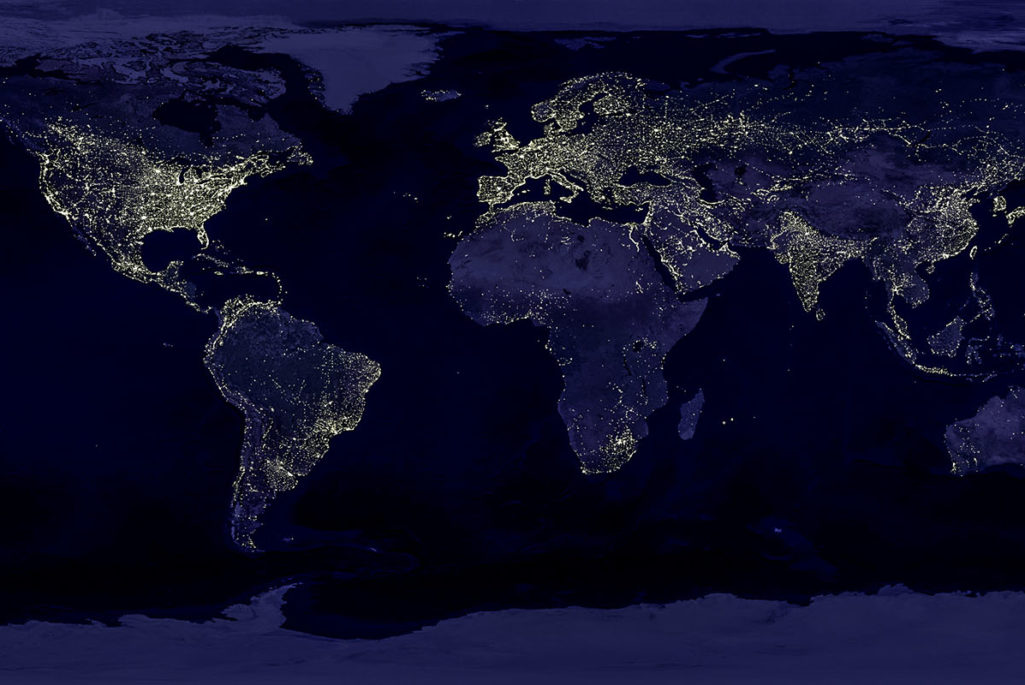A Billion Live Without Electricity. Here’s How We Turn the Lights On

This image of Earth’s city lights was created with data from the Defense Meteorological Satellite Program (DMSP) Operational Linescan System (OLS). Originally designed to view clouds by moonlight, the OLS is also used to map the locations of permanent lights on the Earth’s surface.
Image by: Craig Mayhew and Robert Simmon, NASA GSFC
[Perspectives on Innovation: Part of our regular monthly series featuring content from Perspectives on GE Reports.]
Energy is fundamental to modern life, but 1.2 billion people around the world live without access to “modern electricity.” What does that mean exactly? The current definition is a mere 100 kilowatt-hours (kWh) per person per year for urban areas—enough to power a single light bulb for five hours per day and keep a mobile phone charged—and half as much in rural areas. Such a low bar can have profound implications for national targets, for international goals such as Sustainable Development Goal 7, and on a wide range of critical investment decisions with long-term effects on development.
Human and Developmental Implications
The harm to people living with little energy is very real. Indoor air pollution from burning biomass contributes to 3.5 million premature deaths per year, killing more people worldwide than AIDS and malaria combined. Lack of power also does profound damage to education, the empowerment of women and girls and many other development outcomes.
At a macroeconomic level, energy shortages are a massive drag on economic growth and job creation. Typically, some 70 percent of a nation’s energy is consumed for commercial or industrial purposes, not in the home, and data suggest that power shortages are among the very top constraints to private sector growth.
Efforts Underway
Aggressive electrification was an essential strategy to fight poverty and promote development in countries that are now rich, and it is now the same for the still-developing regions. Power is among the top priorities for governments and citizens alike. The international community is also on board, with efforts such as the UN’s Sustainable Energy for All, the U.S. government’s Power Africa, and many other similar initiatives. The UN’s Sustainable Development Goal 7, for instance, is to “ensure access to affordable, reliable, sustainable and modern energy for all.”
The efforts underway, however, are not enough and pose at least two great risks:
- They aim too low by measuring progress against a single, very low level of electricity consumption.
- They focus too much on household usage at the expense of building a modern energy system that can compete in a global economy.
Five Recommendations for Tracking Energy Access
Given the shortcomings of the current approach to defining and measuring modern energy access, we put forward the following five recommendations for the UN, International Energy Agency, World Bank, national governments, major donors and other relevant organizations:
- Maintain the existing energy access threshold but rename it, more appropriately, the “extreme energy poverty line.” The current use of 100 kWh per capita per year remains valuable as an indicator for the initial rung on the energy ladder. But this level of energy consumption is consistent with only very basic lighting and phone charging. It is the notional equivalent of the extreme poverty line when measuring income, merely a bare minimum starting point rather than the finish line of development success.
- Measure and track household consumption at higher levels for “basic energy access” and “modern energy access.” Energy consumption should be measured at thresholds that balance the competing needs of being simple and aligning with energy demand and historical development patterns. The following two measurements should be added:
- Basic energy access at 300 kWh per capita per year, which would enable running basic appliances such as fans, televisions and refrigerators, which families demand once they have modest additional income.
- Modern energy access at 1,500 kWh per capita per year, a level of consumption consistent with the label “modern” that includes on-demand usage of multiple modern appliances, including air conditioning.
- Create energy level categories to encourage ambitious national energy targets that go beyond household consumption. Modern competitive economies require high levels of energy, the vast majority of which is consumed outside households in the commercial and industrial sectors. We propose the following categories:
- extreme low energy (national average of less than 300 kWh per capita per year)
- low energy (300–1,000)
- middle energy (1,0000–5,000)
- high energy (>5,000)
- Adopt the new thresholds to inform progress-tracking and investment decisions. The new household definitions and country categories could be used by the UN, the African Union, bilateral donors, the World Bank and regional development banks, the U.S. government (for use in Power Africa monitoring and evaluation) and most especially by national governments.
- Invest in data collection on energy consumption, utilizing new technology to improve collection. Additional higher-quality data would allow a better understanding of energy use, help identify gaps and enable better targeting of new investments.
This piece appeared in Perspectives on GE Reports.






